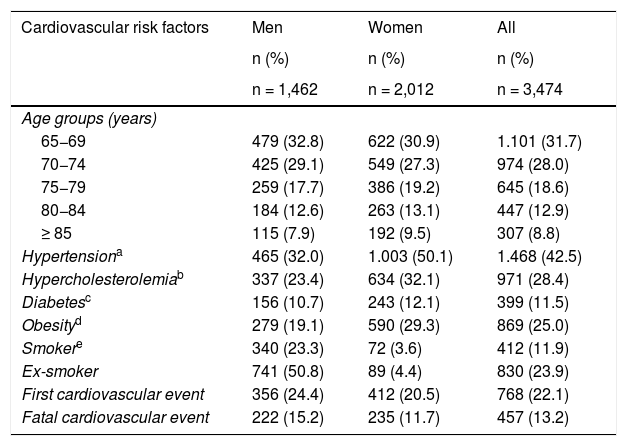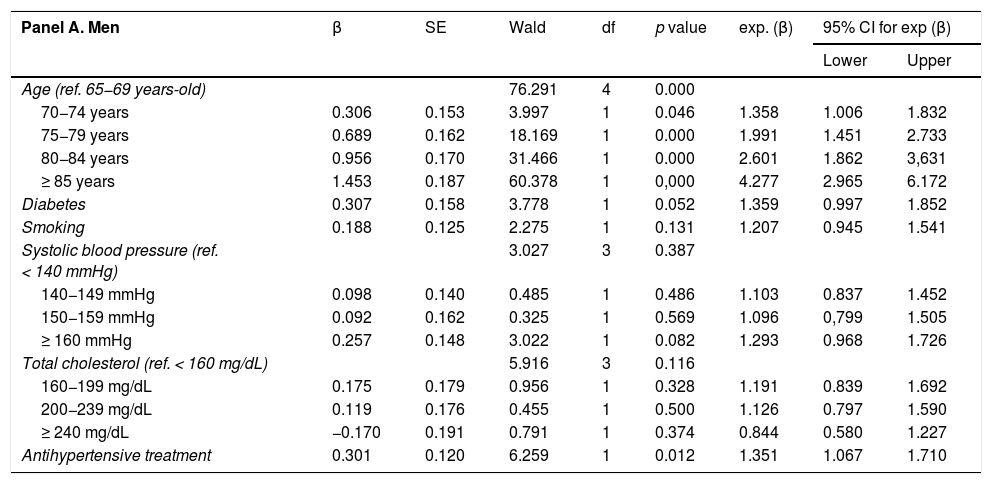Cardiovascular risk estimation in people over 70 years of age is problematic. Most scores have been created based on cohorts of middle-aged people, with an underrepresentation of older adults. The predictive power of classical cardiovascular risk factors declines with age. The aim of this work is to develop a specific score for estimating cardiovascular risk among the elderly population in Spain.
MethodsThis work is a population-based cohort established in 1995. Setting: Three geographical areas of Spain (Madrid, Ávila, and Lugo). Participants: 3,729 people older than 64 years with no cardiovascular diseases (CVD) at baseline. Measurements: Suspected fatal and nonfatal CVD (both coronary heart disease and stroke) were investigated annually and confirmed using the WHO-MONICA criteria. All participants were followed-up on until occurrence of a first CVD event, until death, or until December 31, 2015.
ResultsAge was the strongest predictor of CVD at 10 years in both men and women. In men, variables associated with CVD were high blood pressure treatment (HR: 1.35; 95% CI: 1.067–1.710), diabetes (HR: 1.359; 95% CI: 0.997–1.852), and smoking (HR: 1.207; 95% CI: 0.945–1.541) and in women, the variables were smoking (HR: 1.881; 95% CI: 1.356–2.609) and diabetes (HR: 1.285; 95% CI: 0.967–1.707). Total cholesterol did not increase the risk of CVD in men or women. However, total cholesterol levels >200 mg/dL were inversely associated with 10-year risk of CVD in men and women.
ConclusionsIn elderly Spanish men, total CVD at 10 years is significantly increased by age, diabetes, and antihypertensive treatment and in elderly Spanish women by diabetes and smoking. Total cholesterol levels did not increase the risk of CVD, particularly in males.
La estimación del riesgo cardiovascular en personas mayores de 70 años es problemática. La mayoría de las escalas se han creado basándose en cohortes de personas de mediana edad, con una representación insuficiente de los adultos de más edad. El poder predictivo de los factores de riesgo cardiovascular clásicos disminuye con la edad. El objetivo de este estudio es desarrollar una escala específica para estimar el riesgo cardiovascular de la población anciana española.
MétodosEste estudio se realizó en una cohorte poblacional establecida en 1995. Marco: tres zonas geográficas de España (Madrid, Ávila y Lugo). Participantes: 3.729 personas mayores de 64 años sin enfermedades cardiovasculares (ECV) al inicio del seguimiento. Mediciones: Se investigaron anualmente las sospechas de ECV mortal y no mortal (cardiopatía coronaria e ictus) y se confirmaron usando los criterios del proyecto MONICA de la OMS. Se siguió a todos los participantes hasta que apareció el primer episodio de ECV, hasta su muerte o hasta el 31 de diciembre de 2015.
ResultadosLa edad fue el factor predictivo más potente de ECV a los 10 años en ambos sexos. Las variables asociadas con ECV en los varones fueron el tratamiento de la hipertensión arterial (HR: 1,35; IC al 95%: 1,067−1,710), la diabetes (HR: 1,359; IC al 95%: 0,997−1,852) y el tabaquismo (HR: 1,207; IC al 95%: 0,945−1,541) y en las mujeres, el tabaquismo (HR: 1,881; IC al 95%: 1,356−2,609) y la diabetes (HR: 1,285; IC al 95%: 0,967−1,707). El colesterol-total no aumentó el riesgo de ECV, ni en varones ni en mujeres. Sin embargo, las concentraciones de colesterol total > 200 mg/dL se asociaron inversamente al riesgo de ECV a los 10 años, tanto en varones como en mujeres.
ConclusionesLa ECV total a los 10 años aumenta significativamente en los varones españoles de edad avanzada con la edad, la diabetes y el tratamiento antihipertensivo y en las mujeres con la diabetes y el tabaquismo. Los niveles de colesterol total no aumentaron el riesgo de ECV, sobre todo en los varones.
Article
Diríjase desde aquí a la web de la >>>FESEMI<<< e inicie sesión mediante el formulario que se encuentra en la barra superior, pulsando sobre el candado.

Una vez autentificado, en la misma web de FESEMI, en el menú superior, elija la opción deseada.

>>>FESEMI<<<












